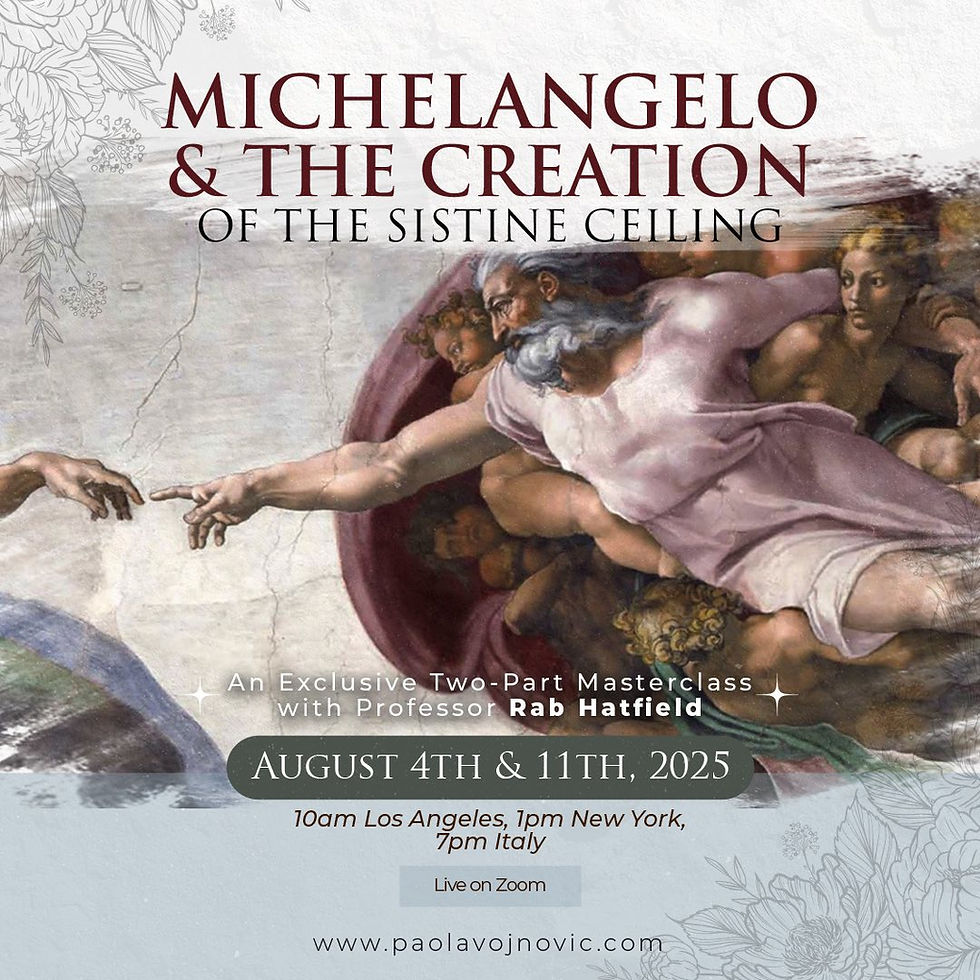Exclusive Two-Part Masterclass: Michelangelo & the Creation of the Sistine Ceiling
- paola50122

- Jul 17
- 3 min read
Updated: Jul 30
Monday, August 4th and 11th
Live on Zoom
6pm London, 7pm Florence, 10am Los Angeles, 1pm New York
(each session will be recorded & yours to keep!)
___________________________________________________________
Paola's Studiolo celebrates the 550th anniversary of the birth of Michelangelo with a special guest, Dr. Robert (Rab) Hatfield, an eminent art historian, and one of the world’s most renowned experts in the art of Michelangelo. He is the author of many important books on Renaissance art, including Trust in God: The Sources of Michelangelo's Frescoes on the Sistine Ceiling; The Wealth of Michelangelo; and his newest book, Soul and Body in Michelangelo – watch the interview, here.
Professor Hatfield acquired his PhD at Harvard. He has been a fellow of Villa I Tatti and is a member of the Institute for Advanced Study at Princeton, as well as a long-time, beloved professor in the Syracuse University Florence program.
To RSVP: Paola50122@gmail.com
Minimum suggested donation: $60
Monday, August 4, 2025, live on Zoom
The Sistine Ceiling, I: Michelangelo and the art of true fresco
In spite of the fact that he first trained with Domenico del Ghirlandaio, perhaps the most proficient fresco painter of his time, Michelangelo knew relatively little about the art of true fresco when he accepted the commission to paint the Sistine Ceiling. True fresco painting involves the application of water colors to a plaster surface that is still “wet”, that is, still in the process of “taking” or hardening. This technique is in many ways the most difficult of all pictorial techniques. Michelangelo was perfectly aware of his relative ignorance of fresco painting. One of his first acts after receiving the commission was to hire five assistants, all of whom had been connected in some way with the Ghirlandaio organization. But in less than a year he fired all five of them and continued alone. His first results were disastrous—so much so that he even considered giving up. But, with a friend’s help, he soon managed to overcome his greatest problem. By the time he reached the far end of the ceiling, (after more than four years of effort!) he had become one of the greatest fresco experts of all time. This talk will concern itself with all of the difficulties faced by any painter of true fresco, as well, of course, as with how Michelangelo was able to overcome these difficulties.
Monday, August 11, 2025, live on Zoom
The Sistine Ceiling, II: Michelangelo’s artistic development as he painted the ceiling
When Michelangelo accepted the commission to paint the Sistine Ceiling, he knew fairly little about the art of painting. Nor did he (or Pope Julius II either) have a very clear idea of what the finished ceiling was expected to look like. The shape of the ceiling is highly unfortunate from the point of view of a painter. It is three times as long as it is wide and is full of indentations and surfaces that curve in two directions. And so, Michelangelo’s first idea was to cover the ceiling with a lot of more or less conventional decoration. But Michelangelo was a figural artist—indeed, probably the greatest master of the human figure who ever lived—and not a decorator. And so he convinced the pope that the ceiling as first envisioned would be a “poor thing” and got him to approve a ceiling with many figures. These figures come, usually in sets of ten or twelve, in various shapes and sizes, some of them seeming to be made of stone and others of flesh and blood. Some are dressed, but many are naked. Running along the long summit of the ceiling, as if seen through openings in it, is a cycle of nine scenes from the beginning of the Book of Genesi, some containing numerous, often naked figures. Now, putting a lot of figures, as well as nine figural pictures, on a ceiling, combined with the “hard”, “sculptural” style with which Michelangelo started out, leads to numerous problems. It is these, along with the ways in which Michelangelo solved these problems and learned to paint more “softly” and “pictorially”, with which this talk will be mainly concerned.




Hello, I would LOVE to attend but have a time conflict. Will it be recorded?